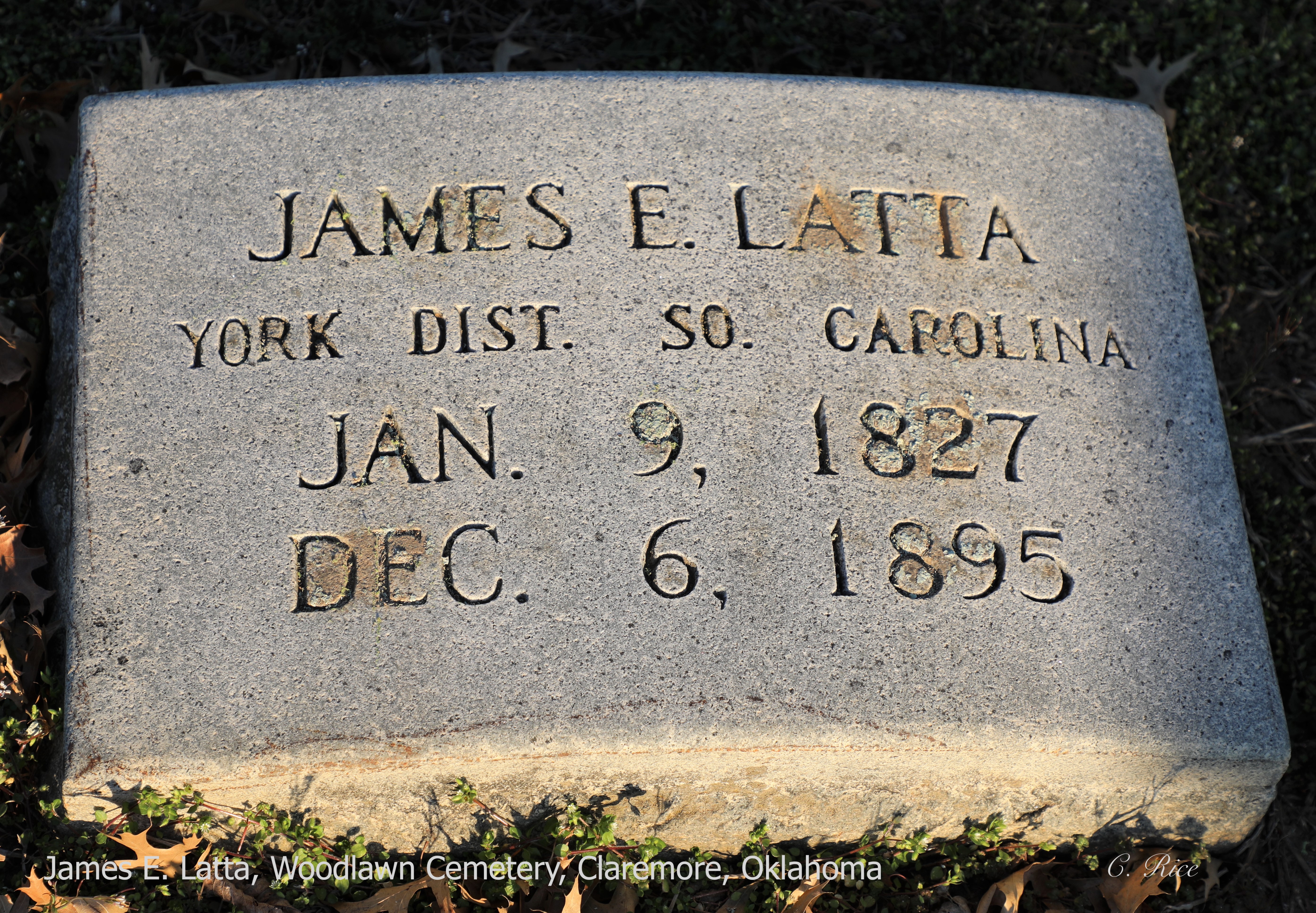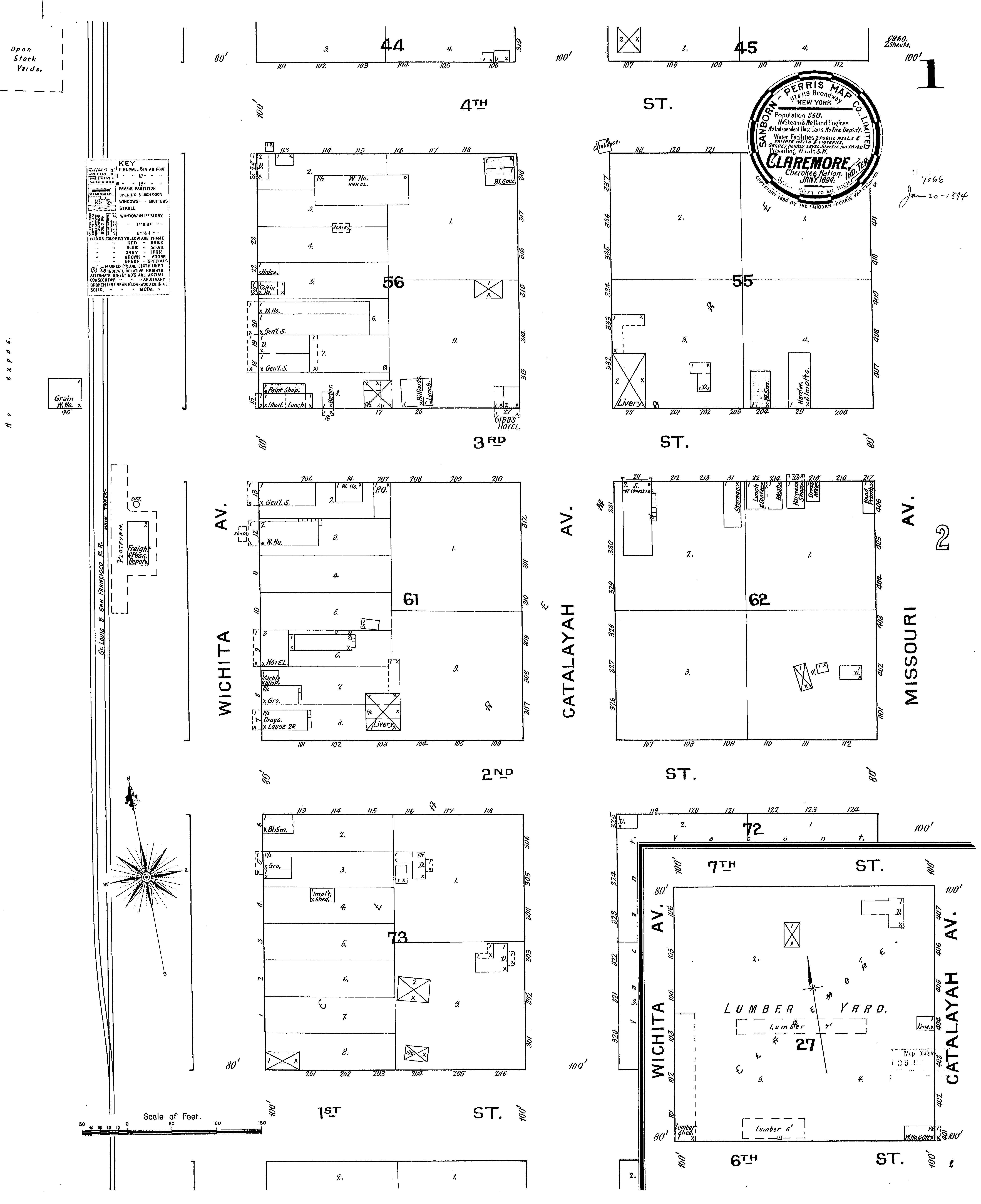
Sanborn Fire Insurance Map, Claremore, Cherokee Nation, Indian Territory, January 1894. Source: Tulsa City-County Library. Wichita Avenue (JM Davis Boulevard), Catalayah Avenue (Lynn Riggs Boulevard), Missouri Avenue. First Street, 2nd Street (Patti Page Boulevard), 3rd Street (Will Rogers Boulevard), 4th Street. The DeVann was, most likely, the 3-story “hotel” on Lot 6, Block 61.
Not many people remember that Clem Rogers owned a hotel in Claremore once upon a time. “There is a hotel in Claremore bearing the name Will Rogers,” The Claremore Progress affirms in September 1931, “but few people know that way back in 1895 Clem Rogers, father of Will, owned a hotel of his own. This hotel, a wooden structure, was located on what is now known as Highway 66 on a site now occupied by J.W. Hammett’s tin shop. The name of the hotel was the Hotel DeVann, and it was operated by Mr. Rogers’ daughter (Mae Mary Rogers Yocum Stine).[i]
“… The Hotel DeVann at a liberal estimate, cost $50,000 to construct… In 1895, board could be obtained for as low as $6 per month. There is a record of a man and his wife who boarded there for some time for the sum of $12 per month…The hotel was named after Mr. Rogers himself, whose name was Clem Vann Rogers.”[ii]
The January 1894, Sanborn Fire Insurance Map, Claremore, Indian Territory, Sheet 1, shows a three-story framed “hotel” with one-story front porch, on the east side of Wichita Avenue (aka J.M. Davis Blvd.) about half way between Second Street and Third Street (aka Will Rogers Boulevard). It is conjectured that this wooden structure was the Yocums’ Hotel DeVann. This building disappears from the June 1896, Sanborn Fire Insurance Map, Claremore, Indian Territory, Sheet 1, but is replaced by a “tin shop” as early as the November 1898, Sanborn Fire Insurance Map, Claremore, Oklahoma, Sheet 2.
The first known advertisement for the Hotel DeVann was found posted in the Claremore Progress, September 8, 1894. “The Hotel DeVann. J.M. Yocum, Proprietor. Near the Frisco Depot. Our table is supplied with all that the market affords. Free hack to and from all trains carrying passengers. McDaniel & Walkley. Livery Feed and Sale Stable in connection with the Hotel DeVann.”[iii]
McDaniel & Walkley ran a horse-drawn cab service “to carry passengers to and from the train for the Hotel DeVann.” Fred Kay, manager of the Cary House, at Nowata, became clerk of the DeVann in November 1894.[iv]
That December, “Considerable emotion was created at J. Bean Burgess’ boarding house… by the appearance of six masked men outside about half past ten o’clock. It (was) supposed that they came after A.J. Blackwell who was under guard there. Whether their intentions were serious or only a bluff can only be conjectured. Blackwell was moved to the Hotel DeVann.”[v]
A.L. Kates, publisher of The Claremore Progress, remembers in an article titled “Hotels of Claremore As I have Known Them,” “When we started living at the McDaniel House (arrived Claremore, June 1893), a new three-story hotel was being built to be known as the Hotel DeVann, and we were given the first room finished in it.”[vi]
Banker Charley Godbey also reminisced about the adventure he and his wife had upon their arrival in Claremore, February 13, 1895. “Arriving at the station here, we were approached by W.R. Aven, who stated that he wanted the job of hauling the banker’s household goods. We informed him that we had no house as yet and would not take them out of the car until we could find a home. So he directed us to the Hotel DeVann, the leading hotel, which was just across the street from the Frisco depot, where the J.W. Hammett tin shop now stands. Arriving at the hotel we met Mr. and Mrs. Mat Yokum, Mrs. Yokum being a sister of Bill Rogers. Here we arranged for supper and a room for the night.”[vii] Claremore, he remembered was “very small, but (had) plenty of cowboys and out laws.”
“We secured board for a sum of $24.00 per month for both of us, very high board at that time, but we were putting up at the best hotel in town.”[viii]
That spring, J.M. Yocum had “his popular hotel, the DeVann, papered down stairs and in the halls, which adds greatly to its appearance.”
The perfect wedding venue, Judge Schrimsher married in January 1895, “at the Hotel DeVann Edgar Halfmoon and Miss Susie Smith.”[ix] Miss Armstrong, of Coody’s Bluff, arrived in Claremore in April “to attend the wedding of her sister at the Hotel DeVann.” “Ben Scovel, of Coffeyville, and Miss Lenora Armstrong, of Coody’s Bluff, were married at the Hotel DeVann …, Clerk LaHay officiating.”[x]
Also in April, The Claremore Progress advertised, “Drs. Davis and Mason, dentist and optical specialist, will be at the Hotel DeVann on next Friday, May 3rd. Dr. Davis, the dentist stands high in his profession and comes here with the best recommendations. He uses all the latest appliances and preparations for extracting and operating painless. He is not only skilled in extracting teeth, but is prepared to do the finest of work in all branches of his profession. Dr. Mason the optician, who accompanies him is a specialist in his line, and will afford our readers, who are troubled with their eyes, an opportunity to have them examined by one who has made it an especial study.”[xi] These were followed by a “Dentist in all its branches. W.B. Badby, D.M.D., at the Hotel DeVann.”[xii]
Mrs. A.B. Seymour, of Coffeyville, Kansas, came to Claremore in December 1895, to “the Hotel DeVann to take orders for dressmaking. All those who desire dresses made in the latest fashion would do well to call. She will cut and fit on those days.”[xiii]
William Gulager, of Tahlequah, and Col. George S. Thebo, of Paris, Texas, were registered as guests at the Hotel DeVann. [xiv] Newly married B.R. Bracefield and wife, from Tulsa, spent a few days at the Hotel DeVann using this hotel as their honeymoon retreat. [xv] Claremore’s premiere hotel was “becoming more popular than ever under the management of mine Host and Hostess, W.R. Gaddis and wife.”[xvi]
Quite sadly, The Claremore Progress announced, December 7, 1895, another worthy guest, “James Latta died yesterday afternoon at the Hotel DeVann at 3:20 after a long and serious illness. The deceased was aged 69 and had resided in the Cherokee nation for the past quarter of a century. He was an elder in the Presbyterian church and highly esteemed by all who knew him.”[xvii]
The ultimate community tragedy was to strike Claremore’s premiere hotel in January 1896 with the report called “Claremore’s First Big Blaze. The Popular Hostelry – The Hotel DeVann – No More. $10,000 Worth Property Destroyed. It Has Come at Last. Six Buildings Now in Ashes.
“A little before two o’clock Saturday morning last, a good portion of our population was aroused by the repeated firing of firearms (for fire alarm) in the business portion of our town. The lower end of town was all lit up and every business man started with the fear that it might be his place of business.
“When the Progress man arrived on the scene the fire was well under way. The three buildings west of the DeVann was all ablaze and the Hotel DeVann was well under way. Hundreds of willing workers were removing the goods from the Hotel DeVann, W.W. Chambers’ building and Davis Hill & Co’s. general merchandise store.
“A stand was taken to confine the fire to the Hotel DeVann and the five adjoining buildings, and by active work and a liberal supply of water, the effort was successful and the Davis Hill and Co’s. store building on the corner, the LaHay building, the barber shop, the butcher shop, the Trilby restaurant and the Hotel DeVann sample room were saved. Had the fire got hold of these buildings, Halsell’s big brick would have been in great peril, and a good part of the business portion of the town would undoubtedly been burned down. While the loss falls heavily on those burned out, the town can congratulate itself that it is no worse. The lack of wind helped the fire fighters there being hardly a breath of air stirring. The workers succeeded in getting out only a little over $300 worth of furniture from the Hotel DeVann…
“The losses as far as we can learn will foot up about $10,000 with only $2,500 insurance. They are made up as follows:
“W.R. Gaddis, furniture in Hotel DeVann, $3,500. Insurance $1,000. About $300 worth of furniture saved. (Note: hotel proprietors owned the business and furnishings only, not the building.)
“C.V. Rogers, Hotel DeVann, $3,500, insurance $1,500…
“Several of the boarders lost part of their clothes and little trinkets that they had in their rooms.
“Several of the boarders at the DeVann made their toilet out in the night air with all nature gazing upon them… Joe LaHay was the first one aroused in the DeVann and the whoops he let out soon awakened even the heaviest sleeper… Dr. Linn saved enough of his shoes from the wreck to supply all those who left the DeVann in such haste that they forgot theirs. Everybody was wearing them. The origin of the fire is a mystery…
“The burning of the Hotel DeVann is a severe loss to our town as well as Mr.& Mrs. W.R. Gaddis, under whose uniting management it had become recognized as one of the best kept hotels in the Territory. They had spared no money in furnishing it throughout in an elegant style, and the almost total loss of their goods, together with being thrown out of the business just at present is a severe loss to them that all regret. It is sincerely hoped that they will soon be established in a new brick hotel here, which our town is sadly in need of.”[xviii]
By Christa Rice, Claremore History Explorer
Sources:
[i] https://www.findagrave.com/memorial/8565002/mae-mary-stine Mae Mary Rogers Stine. Birth 31 May 1873. Death 25 Jul 1909 (aged 36). Spouse: Matthew John Yocum (1865-1896); Frank Charles Stine (1874-1954).
[ii] Claremore Progress (Claremore, Oklahoma). Monday, September 28, 1931 P. 4. Newspapers.com.
[iii] Claremore Progress (Claremore, Indian Terr.). Saturday, December 7, 1894. P. 2. Newspapers.com.
[iv] Claremore Progress (Claremore, Indian Terr.). Saturday, November 17, 1894. P. 5. Newspapers.com.
[v] Claremore Progress (Claremore, Indian Terr.). Saturday, December 1, 1894. P. 3. Newspapers.com.
[vi] Claremore Progress (Claremore, Oklahoma). Thursday, February 13, 1930. P. 5. Newspapers.com.
[vii] Claremore Progress (Claremore, Oklahoma). Thursday, February 19, 1925. P. 4. Newspapers.com.
[viii] Claremore Progress (Claremore, Oklahoma). Thursday, February 15, 1923. P. 2. Newspapers.com.
[ix] Claremore Progress (Claremore, Indian Terr.). Saturday, January 12, 1895. P. 3. Newspapers.com.
[x] Claremore Progress (Claremore, Indian Terr.). Saturday, April 13, 1895. P. 3. Newspapers.com.
[xi] Claremore Progress (Claremore, Indian Terr.). Saturday, April 27, 1895. P. 3. Newspapers.com.
[xii] Claremore Progress (Claremore, Indian Terr.). Saturday, July 6, 1895. P. 3. Newspapers.com.
[xiii] Claremore Progress (Claremore, Indian Terr.). Saturday, December 21, 1895. P. 3. Newspapers.com.
[xiv] Claremore Progress (Claremore, Indian Terr.). Saturday, August 31, 1895. P. 3. Newspapers.com.
Claremore Progress (Claremore, Indian Terr.). Saturday, November 16, 1895. P. 3. Newspapers.com.
[xv] Claremore Progress (Claremore, Indian Terr.). Saturday, November 16, 1895. P. 3. Newspapers.com.
[xvi] Claremore Progress (Claremore, Indian Terr.). Saturday, October 12, 1895. P. 3. Newspapers.com.
Col. W.R. Gaddis, at one time proprietor of the popular Hotel de Vann here, died at Mineral Wells, Texas last week, where he was stopping with the hope of benefitting his health. Claremore Progress (Claremore, Oklahoma). Saturday, February 3, 1900. P. 3. Newspapers.com.
[xvii] Claremore Progress (Claremore, Indian Terr.). Saturday, December 7, 1895. P. 3. Newspapers.com.
[xviii] Claremore Progress (Claremore, Indian Terr.). Saturday, January 18, 1896. P. 3. Newspapers.com.
The full story about the Claremore Downtown Fire, January 1896, can be found here. https://exploreclaremorehistory.wordpress.com/2023/01/18/claremore-fire-january-1896/



You must be logged in to post a comment.